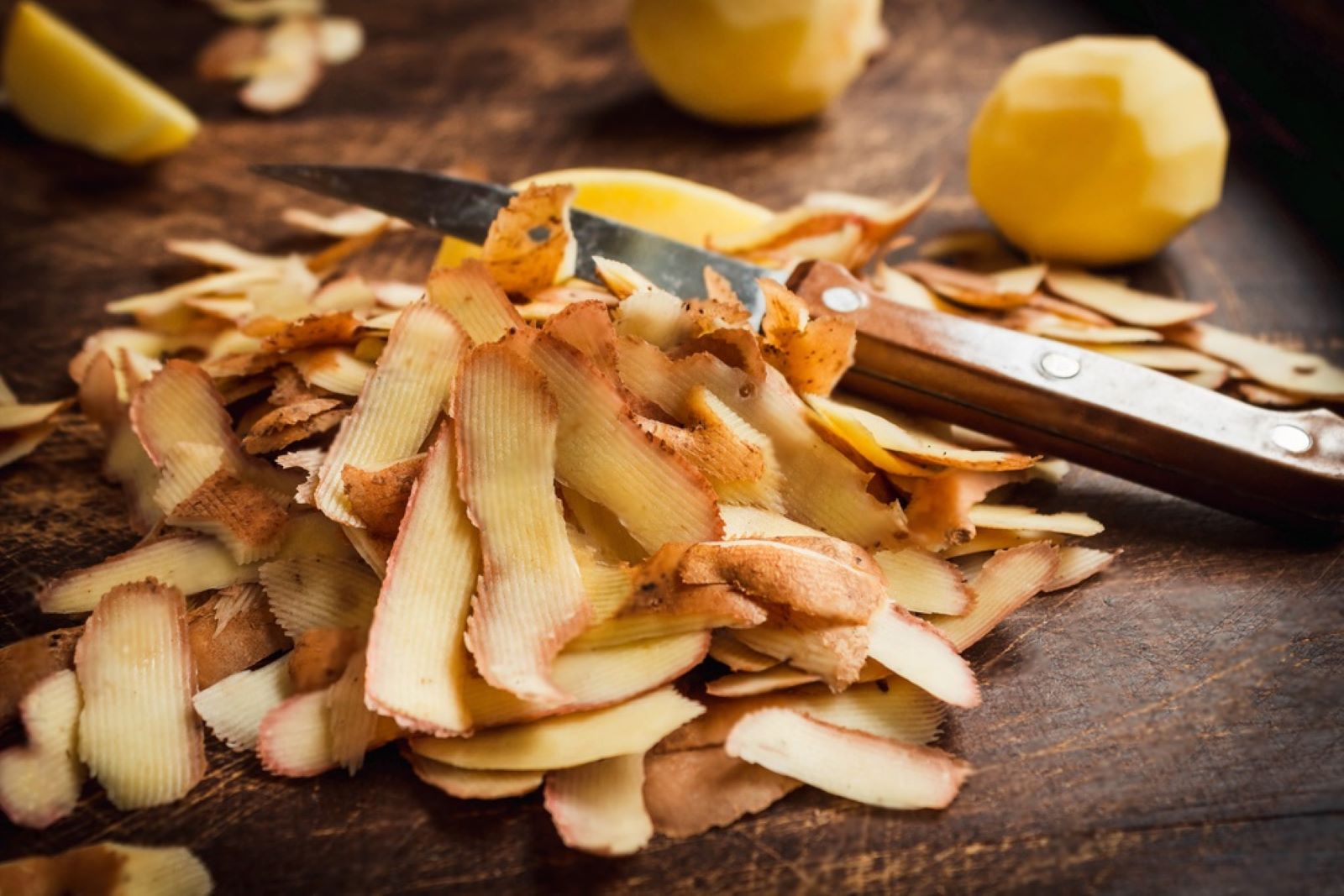
Potato skins, often discarded after the potatoes are peeled for other recipes, are a delectable and underappreciated treat that deserves a place in your culinary repertoire. These nutrient-rich skins are packed with flavor and texture, making them an excellent addition to various dishes. Whether roasted to crispy perfection with a medley of spices, or stuffed with savory fillings and baked to perfection, potato skins offer a delightful twist on the traditional spud. However, when preparing large quantities of potatoes, an abundance of skins may accumulate, leaving us to wonder how to best preserve this overlooked treasure. Freezing potato skins becomes a valuable method to extend their usability, allowing you to enjoy their distinct taste and crunchy goodness in your recipes, even when fresh potato peels are not readily available. In this guide, we will explore the best techniques for freezing potato skins, ensuring that their flavor, texture, and nutritional benefits are lovingly retained, ready to elevate your culinary creations with a touch of rustic charm and delectable taste, whenever you desire a versatile and savory ingredient at your fingertips.
Here are the simple steps to freeze potato skins:
Step 1: Choose Fresh and Clean Potato Skins
All about the importance of choosing fresh and clean potato skins for the freezing process. It highlights the significance of using recently harvested potatoes to ensure that the potato skins are at their best quality, both in terms of taste and texture.
Selecting fresh potato skins is crucial because fresher produce generally retains more nutrients and flavor compared to older, wilted, or damaged ones. Potatoes that have been recently harvested are likely to have a better texture and taste, making them ideal candidates for freezing.
The paragraph also emphasizes the need to ensure that the potato skins are clean and free from any dirt or debris. This step is essential to prevent any contaminants from getting into the freezing process, which could affect the overall quality and safety of the frozen potato skins.
Furthermore, the paragraph mentions that there are different ways to obtain potato skins for freezing. One can collect them while preparing other potato dishes, such as mashed potatoes or fries, by peeling the potatoes. Alternatively, if you have leftover potato skins after preparing a dish, instead of discarding them, you can store them for freezing. Additionally, some individuals may choose to set aside potato skins specifically for the purpose of freezing, especially if they plan to use them for future recipes.
By stressing the significance of starting the freezing process with the best quality potato skins possible, ensuring a successful and enjoyable outcome when using them in various culinary applications later on.
Step 2: Rinse the Potato Skins
Advises rinsing the potato skins under cold running water. This step is essential to ensure that the potato skins are thoroughly cleaned before the freezing process. When potatoes are harvested, they might have some dirt or soil adhering to their skins. Additionally, during the peeling process, there may be residual starch on the surface of the skins.
Rinsing the potato skins under cold running water helps in two ways:
- Removing dirt and debris: The water’s flow effectively washes away any dirt or debris that might be present on the surface of the potato skins. This is important not only for cleanliness but also to avoid any potential contamination during the freezing process.
- Eliminating excess starch: Potatoes contain starch, and when they are peeled, some of this starch may remain on the surface of the skins. Rinsing the skins helps remove this excess starch, preventing them from sticking together during freezing. If starch is not rinsed off, it can cause the potato skins to clump together, making it difficult to separate them later when you need to use just a few at a time.
By giving the potato skins a quick rinse under cold running water, you ensure that they are clean, free from impurities, and ready for the next steps in the freezing process. This simple step contributes to maintaining the overall quality of the frozen potato skins and ensures they retain their freshness and taste when used in various dishes later on.
Step 3: Pat Dry the Skins
Patting dry the potato skins after rinsing them. This step is crucial in the freezing process to remove any excess moisture present on the surface of the potato skins.
Here’s why patting dry the skins is important:
- Preventing ice crystal formation: Excess moisture on the potato skins can lead to the formation of ice crystals when they are frozen. These ice crystals can negatively impact the texture and quality of the potato skins. When water freezes, it expands, and this expansion can cause cell walls to rupture, resulting in a mushy and less appetizing texture when the potato skins are thawed and used in dishes.
- Avoiding freezer burn: Moisture on the surface of the potato skins can also contribute to freezer burn. Freezer burn occurs when the moisture on the surface of the food turns into ice and then dehydrates, leaving behind dry and discolored patches. This can affect the flavor and texture of the potato skins, making them less enjoyable when used in recipes.
By gently patting dry the potato skins with a clean kitchen towel or paper towel, you ensure that excess moisture is removed, reducing the risk of ice crystal formation and freezer burn. It is essential to be gentle during this process to avoid damaging the potato skins or causing any unnecessary bruising.
Step 4: Arrange the Potato Skins
Arranging the potato skins in a specific manner before freezing. This step is essential to ensure that the potato skins freeze individually and do not stick together, making them easier to handle and use in recipes later on.
Here’s the explanation for why arranging the potato skins is important:
- Individual freezing: By laying the potato skins in a single layer on a baking sheet or a tray, you allow each skin to freeze individually. Individual freezing is crucial because it prevents the skins from clumping together. When the potato skins freeze individually, they maintain their separate shapes and won’t fuse together, making it easier to take out just the amount you need when using them in recipes later.
- Preventing sticking: If the potato skins are in direct contact with each other during freezing, they can stick together due to the moisture present on their surfaces. This can make it difficult to separate the skins without damaging them when you need to use them in dishes. By ensuring that the skins do not touch each other during freezing, you avoid this issue altogether.
- Efficient use of freezer space: Arranging the potato skins in a single layer on a baking sheet or tray also optimizes freezer space. Since the skins are spread out, they freeze more quickly and evenly, allowing you to free up space in the freezer faster for other items.
Using parchment paper to line the baking sheet or tray is an additional measure to prevent the potato skins from sticking to the surface. Parchment paper has a non-stick surface, which ensures that the skins won’t adhere to the tray during freezing.
By arranging the potato skins properly, you ensure that they freeze individually and remain separate throughout the freezing process. This ensures that when you store them in a container or freezer bag for long-term storage, they won’t clump together, making it easy to access and use them in various recipes without any hassle.
Step 5: Pre-Freeze the Potato Skins
Pre-freezing the potato skins before transferring them into storage containers or freezer bags for long-term freezing. This step involves placing the baking sheet or tray with the arranged potato skins in the freezer for a short period.
Here’s why pre-freezing the potato skins is important:
- Individual freezing continuation: Pre-freezing the potato skins individually on the baking sheet or tray further ensures that they do not stick together or clump during the long-term freezing process. It allows each skin to freeze separately, maintaining their distinct shapes and preventing them from fusing together.
- Easier portioning: Pre-freezing the potato skins makes them easier to handle during portioning. Since they are partially frozen, they become less delicate and less likely to break or stick together when you transfer them to storage containers or freezer bags. This ensures that you can take out just the amount of potato skins you need for a specific recipe without thawing the entire batch.
- Preventing freezer burn: Pre-freezing helps to seal the surface of the potato skins quickly, reducing the chances of freezer burn. As the skins freeze faster, the water molecules are locked in place, minimizing the risk of dehydration and freezer burn, which can negatively impact the texture and flavor of the potato skins.
- Freeing up space: During pre-freezing, the potato skins take up less space on the baking sheet or tray than they would in a storage container or freezer bag. This allows you to use the pre-freezing time to organize your freezer or make room for other items.
Pre-freezing the potato skins is a crucial intermediate step that ensures the best possible quality and convenience when using them in future recipes. It helps maintain the integrity of the potato skins during the freezing process, guaranteeing that they are ready to be used in a variety of dishes whenever you need them.
Step 6: Package the Potato Skins
Packaging the pre-frozen potato skins into suitable containers or freezer bags for long-term storage. This step is crucial for preserving the quality and freshness of the potato skins while they are in the freezer.
Here’s the explanation for why packaging the potato skins properly is important:
- Protection from freezer burn: Freezer burn occurs when food is exposed to air inside the freezer, causing moisture to evaporate and leaving the food dehydrated. By using freezer-safe, airtight containers or resealable freezer bags, you create a barrier that minimizes air exposure, reducing the risk of freezer burn. Pressing out as much air as possible from the containers or bags further helps in maintaining the potato skins’ texture and taste.
- Prevention of odors and flavors transfer: Airtight packaging also prevents the potato skins from absorbing unwanted odors or flavors from other items in the freezer. This is particularly important for maintaining the unique taste and aroma of the potato skins, ensuring they are as delicious as when they were first frozen.
- Organization and space efficiency: Using proper containers or bags allows for better organization in the freezer. Neatly packed potato skins take up less space and make it easier to access them when needed for cooking.
- Ease of portioning: Packaging the pre-frozen potato skins individually allows you to take out only the amount you need for a specific recipe without thawing the entire batch. This makes portioning more convenient and reduces potential food waste.
Properly packaged and sealed, the potato skins can now be safely stored in the freezer for an extended period, usually up to several months, without compromising their quality. When it’s time to use them, you can easily retrieve the desired amount without any hassle or concerns about freezer burn or loss of flavor.
Step 7: Label and Date the Packages
Emphasizes the importance of labeling and dating the packages containing the frozen potato skins. This step is crucial for ensuring proper organization and efficient use of the frozen potato skins.
Here’s the explanation for why labeling and dating the packages is essential:
- Easy identification: By labeling the containers or freezer bags with the contents (in this case, “potato skins”) and the date of freezing, you can easily identify what is inside each package without having to open them. This is especially helpful if you have multiple types of frozen items in the freezer. You can quickly locate the potato skins and use them as needed in various recipes.
- Rotating stock: Labeling with the date of freezing allows you to keep track of the age of the frozen potato skins. It ensures that you use the oldest batch first (first in, first out), preventing them from being forgotten and becoming freezer-burnt or past their optimal quality. This rotation helps avoid food waste and ensures you enjoy the potato skins at their best.
- Recommended storage duration: Different foods have different recommended storage durations in the freezer before their quality starts to decline. By dating the packages, you can easily keep track of how long the potato skins have been frozen. This way, you can plan to use them within the recommended time frame to maintain their taste and texture.
- Meal planning and inventory management: Labeling and dating the packages allow you to plan meals effectively and manage your freezer inventory. You can take note of how much of the frozen potato skins you have left and incorporate them into your meal plans accordingly.
By taking a few moments to label and date the packages, you ensure that the frozen potato skins are organized, easy to find, and used in a timely manner. This simple step helps you maintain an efficiently managed freezer and ensures that you enjoy the best quality of the potato skins whenever you decide to use them in your favorite dishes.
Step 8: Store in the Freeze
Storing the packaged potato skins in the freezer properly. This step is critical to maintaining the quality and safety of the frozen potato skins throughout their storage period.
Here’s the explanation for why storing the potato skins correctly in the freezer is important:
- Maintaining freezing efficiency: Placing the packaged potato skins in the freezer’s coldest part ensures that they freeze quickly and evenly. A colder area of the freezer maintains a more stable temperature, which is crucial for preserving the quality of the potato skins. Rapid freezing helps to retain the skins’ texture and taste, preventing the formation of large ice crystals that can negatively impact their quality.
- Avoiding temperature fluctuations: The freezer’s coldest part is less susceptible to temperature fluctuations caused by opening and closing the freezer door frequently. Consistent temperatures are essential for food preservation, and keeping the packaged potato skins in a stable environment helps maintain their freshness and quality.
- Preventing overcrowding: Avoid overloading the freezer with too many items, as this can affect the freezer’s efficiency. When the freezer is overcrowded, the circulation of cold air may be restricted, leading to uneven freezing and potential temperature fluctuations. Adequate space around the packaged potato skins allows for proper airflow, optimizing freezing conditions.
- Preventing contamination: Storing the packaged potato skins away from other strong-smelling foods can help prevent cross-contamination of flavors. Potato skins, like other foods, can absorb odors from neighboring items in the freezer. By keeping them separate from strongly scented foods, you ensure the potato skins retain their natural taste and aroma.
By storing the packaged potato skins properly in the freezer’s coldest part and without overloading it, you can ensure that the skins freeze efficiently and remain in top condition until you’re ready to use them in your favorite recipes. Proper storage is key to enjoying the best quality of the potato skins whenever you need them.
How long can potato skins last in the freezer?
Potato skins can last in the freezer for about 6 to 8 months when stored in proper freezer-safe, airtight containers or resealable freezer bags. To maintain their quality, ensure they are pre-frozen, labeled with the date of freezing, and stored in the coldest part of the freezer. Using them within the recommended storage duration ensures the best taste and texture when incorporated into various dishes.
Other related questions
How do you defrost potato skins?
To defrost potato skins, remove the desired amount from the freezer and place them in the refrigerator. Allow them to thaw overnight or for several hours until fully defrosted. Avoid using a microwave for defrosting, as it can lead to uneven thawing and may affect the texture of the potato skins.
Can you refreeze potato skins?
It is generally not recommended to refreeze potato skins once they have been thawed. Refreezing can lead to a loss of texture, taste, and overall quality of the potato skins. To maintain the best taste and safety, it’s advisable to use thawed potato skins promptly and avoid refreezing them.
How do I know if the potato skins have gone bad after being frozen?
To determine if frozen potato skins have gone bad, look for signs of freezer burn, such as dry, discolored patches or ice crystals on the surface. Rancid or off-putting odors may also indicate spoilage. If the texture appears mushy or the taste is significantly altered, it’s best to discard them as these are indications of deteriorated quality. Always follow proper freezing and storage guidelines to extend the shelf life of frozen potato skins.
Are frozen potato skins suitable for making snacks?
Yes, frozen potato skins can be suitable for making snacks. When properly frozen and stored, potato skins can retain their texture and flavor, making them a convenient option for snacks like loaded potato skins. However, it’s crucial to follow proper freezing and thawing techniques to maintain their quality and prevent any changes in taste or texture.
Can you freeze sweet potato skins as well?
Yes, you can freeze sweet potato skins. Sweet potato skins can be frozen similarly to regular potato skins. It’s important to ensure they are thoroughly cooled before freezing and stored in airtight containers or freezer bags to maintain their quality. However, keep in mind that like regular potato skins, there may be some changes in texture upon thawing, but they can still be used for making snacks or other recipes.
Are frozen potato skins as crispy as fresh ones when cooked?
Frozen potato skins may not be as crispy as fresh ones when cooked. The freezing and thawing process can cause some moisture to be released, which may affect the skin’s crispiness. To improve crispiness, consider baking or frying the thawed potato skins at a slightly higher temperature or adding a light coating of oil before cooking.
Can frozen potato skins be used for soups or stews?
Yes, frozen potato skins can be used in soups or stews. When added to soups or stews, the potato skins can infuse the dish with added flavor and nutrients. However, it’s essential to ensure the frozen potato skins are thawed before using them in the recipe to prevent any texture or cooking time issues.








